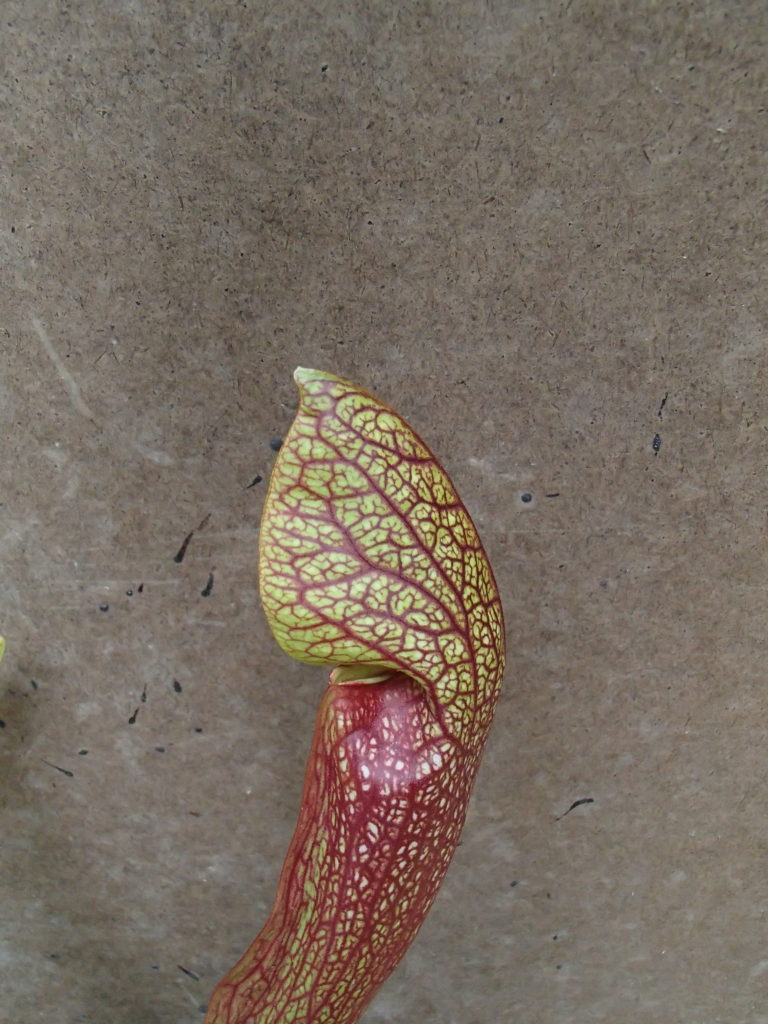‘Dixie Lace’ Pitcherplant is a hybrid, introduced by local NC botanists Larry Mellichamp and Rob Gardner. Technically, the lineage is: (Sarracenia leucophylla x Sarracenia rubra ssp. wherryi) x (Sarracenia psittacina x Sarracenia purpurea). A cross of two hybrid crosses! But do not be dismayed, the genes are local as all Sarracenias are North American in origin. (The USDA plant distribution link below is for the genus Sarracenia.) In mid-spring, there are 18-inch flower stalks with dangling maroon red flowers. Then there is lovely maroon veining and a curved hood on each emerging pitcher, growing into in a wonderful, fat clump of colorful pitchers about one foot in height, but 18″ wide. Insects and spiders are attracted to and passively “captured” in the pitchers, where their soft parts are digested enzymatically. Sarracenias evolved in habitats low in nitrogen and phosphorus, nutrients which are therefore derived instead from insect prey. Cultivated pitcherplants should never be fertilized. ‘Dixie Lace’ can easily be grown in a container in peatmoss and perlite or sand, in full sun, and watered with deionized water (to control salt accumulation), as long as it is allowed to undergo a cold spell in the winter when it is dormant and is not permitted to dry out.
NURSERY HOURS
Wednesday: 10-4 Thursday: 10-6 Friday-Saturday: 10-4 Sunday: 12-4
Sarracenia ‘Dixie Lace’

Key Info
Scientific Name: Sarracenia 'Dixie Lace'
Common Names: Dixie Lace
Family Names: Sarraceniaceae
Light Requirement: Full sun
Flower Color: Red
Additional Info
Habit: Sarracenias are clump-forming herbaceous perennials that grow as rosettes from a branching rhizome, forming colonies and containing fibrous roots 8-12 inches long along its length. The pitchers are modified leaves that (in addition to their function of photosynthesis) attract and entrap their insect prey by means of colorful presentation and nectar production (like flowers) and modifications to prevent escape. Wikipedia has a concise treatment of Sarracenia's entrapment mechanisms.
Height: 6"-12"
Spread: 1'
Soil Conditions: Moist or wet, nutrient-poor, peaty, acidic soils.
Leaves: 'Dixie Lace' pitchers, which have a very marked reticulate pattern ("Lace") of deep red veins, grow to about 10 inches tall and are poised erect to slightly arching outwards. The hood is strongly rounded with laterally flared sides, about 1½ inches across below the hood. Sturdy pitchers are produced throughout the growing season, and many pitchers survive well into the winter. This plant infrequently produces slender, linear, winter leaves (phyllodia).
Flowers (or reproductive structures: In spring, flowers arise on leafless stalks to 12-15 inches tall. Flowers are held above the pitchers, avoiding entrapment of pollinators. Flowers are round, fragrant, with 5 petals, maroon red and pendulous.
Fruit: Each flower is followed by a dry 5-parted seed capsule that splits open along 5 seams at maturity (June/July) exposing small, papery, pear-shaped seeds. The seeds fall near the parent plant. Seeds of 'Dixie Lace' will not be true. Propagate by division.
Natural Distribution: Sarracenias live in any permanently moist site including swamps, lake edges, river banks, boggy pine forests, or other low-lying areas. They cannot live in permanently flooded areas, but survive well in areas that experience temporary seasonal floods and submersion. They cannot tolerate long-term drought.
USDA Hardiness Zone: 6 to 9
USDA Wetland Indicator Status in NC: OBL
Pollination: Bees and other insects.
Wildlife Connections: Obtains nutrients (nitrate and phosphate) from insects. Insects and other tiny creatures are attracted by the nectar and coloration of the traps. The main prey of Sarracenias are ants, flies, wasps, bees, beetles, slugs and snails.
Propagation: A hybrid cross, 'Dixie Lace' is propagated by division.
